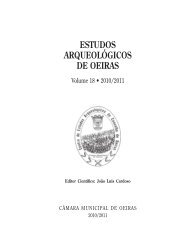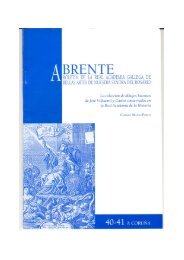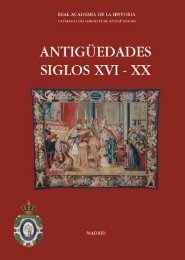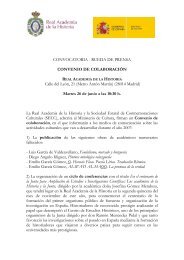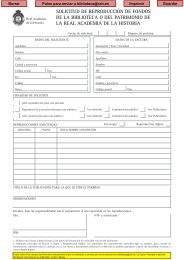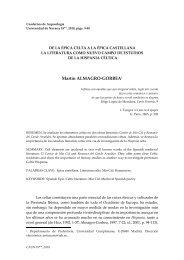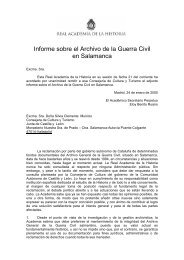Apéndice II Sistema Monetario GriegoREAL ACADEMIA DE LA HISTORIASISTEMAS METROLÓGICOS GRIEGOSSegún <strong>la</strong>s áreas <strong>de</strong> emisión, los patrones métricos utilizadosvariaron en pesos y equivalencias. A continuaciónse exponen los sistemas más utilizados según <strong>la</strong>s zonas 66 .Reino <strong>de</strong> Lidia (Primera mitad <strong>de</strong>l siglo VI a.C.):Sistema bimetálico <strong>de</strong> oro y p<strong>la</strong>ta:AV.- Estátera <strong>de</strong> 8,05 g. con divisores <strong>de</strong> hasta 1/12(hemihekton); <strong>la</strong> re<strong>la</strong>ción entre el oro y <strong>la</strong> p<strong>la</strong>ta es <strong>de</strong>1=13 (1/13).AR.- Estátera <strong>de</strong> 11 g.; su hemihekton equivale a1/120 <strong>de</strong>l <strong>de</strong> oro.Jonia Se mantiene el uso <strong>de</strong>l electro con divisores <strong>de</strong>hasta 1/96º <strong>de</strong> estátera; a finales <strong>de</strong> siglo VI, seintroduce <strong>la</strong> p<strong>la</strong>ta que favorece <strong>la</strong> aparición <strong>de</strong>patrones locales para cada taller:Milesio: Estátera <strong>de</strong> 14,1 g.Euboico: Estátera <strong>de</strong> 17,2 g.Focense: Estátera <strong>de</strong> 16,1 g.Fidoniano o Eginético La dracma egineta pesaba 6,16 g.,se amonedaba en didracmas o estáteras <strong>de</strong> 12,32 g.Se usó en Egina, Peloponeso, Beocia, Tesalia, Fócida,parte <strong>de</strong> <strong>la</strong>s Cíc<strong>la</strong>das, Creta, etc..., fue un sistemamuy difundido por el papel comercial <strong>de</strong> Egina; cabe<strong>la</strong> posibilidad <strong>de</strong> que su origen sea un patrón pon<strong>de</strong>ralinstituido por Fidón <strong>de</strong> Argos.Ático Tetradracma <strong>de</strong> 17,44 g.; dracma <strong>de</strong> 4,36 g.;óbolo <strong>de</strong> 0,72 g. Se usó en Atenas, Eubea, granparte <strong>de</strong> Siclia, Delos, Cirenaica y será el que posteriormenteimponga Alejandro III el Magno entodos sus dominios. Las dracmas áticas <strong>de</strong> NuevoEstilo pesaban en torno a 4,2 g.Corintio Estátera <strong>de</strong> 8,6 g, que se correspondía con unadidracma ática, pero que generalmente se amonedabacon tridracmas <strong>de</strong> 8,70 g. con dracmas <strong>de</strong> 2,90 g.Fue usado en Corinto, Ambracia y Leucas.Eubeo Estátera <strong>de</strong> 17,2 g. Contempló en su sistema <strong>la</strong>creación <strong>de</strong> moneda fraccionaria con <strong>de</strong>nominacionescomo tercios, sextos, etc...Campaniense o Aqueo/Itálico Estátera <strong>de</strong> 8 g., muyusado también en <strong>la</strong>s colonias <strong>de</strong> <strong>la</strong> Magna Grecia,<strong>de</strong> ahí su nombre. Sus dracmas pesaban 3,75 g.66Las <strong>monedas</strong> <strong>de</strong> oro <strong>de</strong> época clásica y helenística seguían los patronesmétricos áticos o los impuestos por Alejandro III, teniendocomo excepción el sistema persa en el que un dárico pesaba 8,4 gr.Samnio Su moneda base era <strong>la</strong> tridracma <strong>de</strong> 13,10 g.Tracio-Macedonio Abarca todo el complejo mundo <strong>de</strong>lnorte <strong>de</strong> Grecia, con diferentes situaciones. Se utilizanestáteras <strong>de</strong> 9,8 g. y otras <strong>de</strong>nominacioneshasta que asumió <strong>de</strong>l sistema ático.Corciro Sistema utilizado en <strong>la</strong> is<strong>la</strong> <strong>de</strong> Corcira y queextendió por <strong>la</strong>s colonias calcídicas <strong>de</strong> Sicilia(Zancle, Himera, Naxos,...) que con el tiempo seacogieron al sistema ático.Sicilia Su sistema estaba basado en el bronce, con <strong>la</strong> litracomo medida <strong>de</strong> peso básica (106 g.). Su equivalenteen <strong>la</strong> p<strong>la</strong>ta era una pieza <strong>de</strong> 0.86 g (un quinto <strong>de</strong>una dracma ática). En el siglo V a.C. prácticamentetoda <strong>la</strong> is<strong>la</strong> adoptó el sistema ático. Fueron los primerosen marcar <strong>la</strong>s <strong>monedas</strong> con caracteres o símbolospara i<strong>de</strong>ntificar su valor, innovación que pasaría posteriormentea Roma.Pentekontalitron: 50 litras 67 .Decalitra:10 litras = 1 didracma.Pentalitron:5 litras = 1 dracma.Dilitron:2 litras (211,2 g.)Litra:12 uncias (105,6 g.).Hemilitron: 1/2 litra = 6 uncias (52,8 g.).Pentokion:5 uncias = 1 hemióbolo (44 g.).Tetraonkion: 4 uncias (35,3 g.)Trias:3 uncias (26,4 g.)Hexante:2 uncias (17,6 g.).Onkia:1 uncia (8,8 g.).Imperio Persa Modificaba el mo<strong>de</strong>lo lidio ligeramente.AV.- Dárico <strong>de</strong> 8.35 g.AR.- Shekel <strong>de</strong> 5,35-55 g., más ligero que el lidio.La re<strong>la</strong>ción es 1/20.Fenicio Shekel <strong>de</strong> p<strong>la</strong>ta <strong>de</strong> 7 g., con fracciones y múltiplos.Se llegaban a intercambiar por dos dracmas. Elsistema lo encontramos en piezas acuñadas en Tracia,Macedonia, Cólqui<strong>de</strong>, Egipto, Cirenaica y Cartago.Proce<strong>de</strong> <strong>de</strong> <strong>la</strong>s acuñaciones en electro <strong>de</strong> Mileto y sudracma equivalía a 3,60 g. De este sistema evolucionael sistema púnico.67Según escribió Diodoro en el siglo I a.C. (Biblioteca Historica) existíaen Sicilia una pieza l<strong>la</strong>mada Demareteion, acuñada en honor a Demarete,mujer <strong>de</strong> Gelon I <strong>de</strong> Siracusa, por <strong>la</strong> ayuda prestada para alcanzar<strong>la</strong> paz con los cartagineses tras <strong>la</strong> batal<strong>la</strong> <strong>de</strong> Himera en el 480 a.C.Sería una serie más <strong>de</strong>ntro <strong>de</strong> <strong>la</strong>s <strong>de</strong>cadracmas siracusana (10 dracmasáticas) y se <strong>de</strong>nominaría también Pentekontalitron. Hay fuentesque incluso llegan a afirmar que el retrato que aparece en estas <strong>monedas</strong>y en <strong>la</strong>s <strong>de</strong>cadracmas siracusanas posteriores no sería el <strong>de</strong> <strong>la</strong>ninfa Arethusa, sino el <strong>de</strong> <strong>la</strong> propia Demarete; sin embargo, en <strong>la</strong>actualidad, esta i<strong>de</strong>ntificación esta prácticamente rechazada.210
MONEDAS GRIEGASApéndice II Sistema Monetario GriegoEQUIVALENCIASDracmas Óbolos LitrasESTÁTERA <strong>de</strong> oro 20 120 100Do<strong>de</strong>cadracma 12 72 60Decadracma 10 60 50Octodracma 8 48 40Pentadracma 5 30 25Tetradracma 4 24 20Tridracma 3 18 15Didracma 2 12 10DRACMA 1 6 5Pentóbolo 5/6 5 25/6Tetróbolo 3/4 4 10/3Trióbolo 1/2 3 2,5Dióbolo 1/3 2 5/3Trihemióbolo 1/4 1,5 5/4ÓBOLO 1/6 1 5/6Tritetartemorion 1/8 3/4 5/8Trihemitartemorion 1/16 3/8 5/16Tetartemorion 1/24 1/4 5/24Hemitetartemorion 1/48 1/8 5/48Según Jean Babelon 68 , en el santuario panhelénico <strong>de</strong>Delfos se cambiaba un tetróbolo egineta (4,25 g. <strong>de</strong>p<strong>la</strong>ta) por una dracma ática (4,36 g. <strong>de</strong> p<strong>la</strong>ta); un dióboloegineta (2,12 g.) por un trióbolo ático (2,18 g.) yel óbolo egineta (1,06 g.) por un trihemióbolo ático(1,09 g.). A su vez, el trihemióbolo corintio era equivalenteal óbolo ático (0,72 g.), el trióbolo corintio aldióbolo ático (1,45 g.) y el dióbolo persa al trióbolomilesio.Sistemas <strong>de</strong> Cuenta en peso 69 :Se utilizaba como <strong>de</strong>nominación para <strong>la</strong>s piezas enOriente, pero según el patrón ático:Mina = 100 dracmas (436,6 g.)Talento = 60 Minas = 6000 dracmas.68BABELON, J. (1964). La Numismatique Antique.Paris, pp. 27-2869Hay varios sistemas <strong>de</strong> cuenta en peso, por ello <strong>de</strong>bemos tomarlocon muchas reservas. El que nosotros aquí presentamos es elmás repetido por los autores especializados.211
- Page 1:
ANTIQUARIA HISPANICA1. M. ALMAGRO-G
- Page 6 and 7:
VICO BELMONTE, AnaMonedas Griegas /
- Page 8 and 9:
REAL ACADEMIA DE LA HISTORIACOMISI
- Page 10 and 11:
ÍndiceREAL ACADEMIA DE LA HISTORIA
- Page 12 and 13:
ÍndiceREAL ACADEMIA DE LA HISTORIA
- Page 15:
PRESENTACIÓNEl Rey Fernando VI est
- Page 18 and 19:
IntroducciónREAL ACADEMIA DE LA HI
- Page 20 and 21:
IntroducciónREAL ACADEMIA DE LA HI
- Page 22 and 23:
IntroducciónREAL ACADEMIA DE LA HI
- Page 24 and 25:
IntroducciónREAL ACADEMIA DE LA HI
- Page 26 and 27:
IntroducciónREAL ACADEMIA DE LA HI
- Page 28 and 29:
IntroducciónREAL ACADEMIA DE LA HI
- Page 30 and 31:
IntroducciónREAL ACADEMIA DE LA HI
- Page 32 and 33:
IntroducciónREAL ACADEMIA DE LA HI
- Page 34 and 35:
IntroducciónREAL ACADEMIA DE LA HI
- Page 36 and 37:
IntroducciónREAL ACADEMIA DE LA HI
- Page 38 and 39:
Mapa 1. Las culturas del Mediterrá
- Page 40 and 41:
Normas de uso del CatálogoREAL ACA
- Page 42 and 43:
Abreviaturas bibliográficasREAL AC
- Page 44 and 45:
Mapa 2. Zona de la Galia con las ce
- Page 46 and 47:
Galia (10-17)REAL ACADEMIA DE LA HI
- Page 48 and 49:
Mapa 3. Magna Grecia.
- Page 50 and 51:
Magna Grecia (24-30)REAL ACADEMIA D
- Page 52 and 53:
Magna Grecia (38-43)REAL ACADEMIA D
- Page 54 and 55:
Magna Grecia (50-57)REAL ACADEMIA D
- Page 56 and 57:
Magna Grecia (65-70)REAL ACADEMIA D
- Page 59 and 60:
SICILIA
- Page 61 and 62:
MONEDAS GRIEGAS Sicilia (78-83)AETN
- Page 63 and 64:
MONEDAS GRIEGAS Sicilia (91-97)94.
- Page 65 and 66:
MONEDAS GRIEGAS Sicilia (105-113)47
- Page 67 and 68:
MONEDAS GRIEGAS Sicilia (121-128)An
- Page 69:
MONEDAS GRIEGAS Sicilia (136-141)ME
- Page 72 and 73:
Mapa 5. Tracia, Macedonia, Tesalia,
- Page 74 and 75:
Tracia (149-154)REAL ACADEMIA DE LA
- Page 76 and 77:
Macedonia (164-172)REAL ACADEMIA DE
- Page 78 and 79:
Macedonia (180-187)REAL ACADEMIA DE
- Page 80 and 81:
Macedonia (197-204)REAL ACADEMIA DE
- Page 82 and 83:
Macedonia (212-219)REAL ACADEMIA DE
- Page 84 and 85:
Iliria (227-234)REAL ACADEMIA DE LA
- Page 86 and 87:
Beocia (241-246)REAL ACADEMIA DE LA
- Page 88 and 89:
Atica (254-261)REAL ACADEMIA DE LA
- Page 90 and 91:
Corintia (270-279)REAL ACADEMIA DE
- Page 92 and 93:
Sicionia (292-298)REAL ACADEMIA DE
- Page 94 and 95:
Islas de Egeo (305-309)REAL ACADEMI
- Page 96 and 97:
Mapa 6. Cecas del Bósforo, Ponto,
- Page 98 and 99:
Bósforo (316-322)REAL ACADEMIA DE
- Page 100 and 101:
Misia (329-336)REAL ACADEMIA DE LA
- Page 102 and 103:
Jonia (342-350)REAL ACADEMIA DE LA
- Page 104 and 105:
Isla de Rodas (357-362)REAL ACADEMI
- Page 106 and 107:
Reinos Seleúcidas (369-375)REAL AC
- Page 108 and 109:
Reinos Seleúcidas (384-390)REAL AC
- Page 110 and 111:
Reinos Seleúcidas (398-406)REAL AC
- Page 112 and 113:
Reinos Seleúcidas (414-421)REAL AC
- Page 114 and 115:
Reinos Seleúcidas (430-436)REAL AC
- Page 116 and 117:
Reinos Seleúcidas (445-456)REAL AC
- Page 118 and 119:
Siria (465-472)REAL ACADEMIA DE LA
- Page 120 and 121:
Siria (482-487)REAL ACADEMIA DE LA
- Page 122 and 123:
Fenicia (497-503)REAL ACADEMIA DE L
- Page 124 and 125:
Fenicia (512-520)REAL ACADEMIA DE L
- Page 127 and 128:
JUDEA, PALESTINA, ARABIA, BABILONIA
- Page 129 and 130:
MONEDAS GRIEGAS Judea (528-535)JUDE
- Page 131 and 132:
MONEDAS GRIEGAS Judea (545-553)tos,
- Page 133 and 134:
MONEDAS GRIEGAS Judea (563-571)563.
- Page 135 and 136:
MONEDAS GRIEGAS Judea (583-591)da c
- Page 137 and 138:
MONEDAS GRIEGAS Judea (601-609)601.
- Page 139 and 140:
MONEDAS GRIEGAS Judea (619-627)Anv.
- Page 141 and 142:
MONEDAS GRIEGAS Judea (636-645)Anv.
- Page 143 and 144:
MONEDAS GRIEGAS Judea (656-665)Anv.
- Page 145 and 146:
MONEDAS GRIEGAS Babilonia (000-000)
- Page 147 and 148:
MONEDAS GRIEGAS Edipto (689-695)Pto
- Page 149 and 150:
MONEDAS GRIEGAS Egipto (702-708)702
- Page 151 and 152:
MONEDAS GRIEGAS Egipto (714-718)Rev
- Page 153 and 154:
MONEDAS GRIEGAS Egipto (725-730)Anv
- Page 155 and 156:
MONEDAS GRIEGAS Egipto (738-744)Cop
- Page 157 and 158:
MONEDAS GRIEGAS Egipto (752-759)752
- Page 159 and 160:
MONEDAS GRIEGAS Egipto (767-771)Anv
- Page 161 and 162: CIRENAICA, CERDEÑA, ZEUGITANIA,SIC
- Page 163 and 164: MONEDAS GRIEGAS Cirenaica (774-779)
- Page 165 and 166: MONEDAS GRIEGAS Monedas Púnicas (7
- Page 167 and 168: MONEDAS GRIEGAS Monedas Púnicas (8
- Page 169 and 170: MONEDAS GRIEGAS Monedas Púnicas (8
- Page 171 and 172: MONEDAS GRIEGAS Zeugitania (843-852
- Page 173 and 174: MONEDAS GRIEGAS Zeugitania (862-868
- Page 175 and 176: MONEDAS GRIEGAS Sicilia Púnica (87
- Page 177 and 178: MONEDAS GRIEGAS Sicilia Púnica (90
- Page 179: MONEDAS GRIEGAS Mauritania (916-918
- Page 183 and 184: MONEDAS GRIEGAS Monedas Inclasifica
- Page 185 and 186: MONEDAS GRIEGAS Monedas Falsas (975
- Page 187: MONEDAS GRIEGAS Nuevas Adquisicione
- Page 191 and 192: 1. GLOSARIO DE TÉRMINOSAcarnania:
- Page 193 and 194: MONEDAS GRIEGASApéndice I Glosario
- Page 195 and 196: MONEDAS GRIEGASApéndice I Glosario
- Page 197 and 198: MONEDAS GRIEGASApéndice I Glosario
- Page 199 and 200: MONEDAS GRIEGASApéndice I Glosario
- Page 201 and 202: MONEDAS GRIEGASApéndice I Glosario
- Page 203 and 204: MONEDAS GRIEGASApéndice I Glosario
- Page 205 and 206: MONEDAS GRIEGASApéndice I Glosario
- Page 207 and 208: MONEDAS GRIEGASApéndice I Glosario
- Page 209: MONEDAS GRIEGASApéndice I Glosario
- Page 215 and 216: 3. CRONOLOGÍA DE LAS DINASTÍAS RE
- Page 217: MONEDAS GRIEGASApéndice III Cronol
- Page 220 and 221: Apéndice IV Monedas con Procedenci
- Page 222 and 223: LÁMINAS12345678910111213141516Masa
- Page 224 and 225: GH25_Laminas 01 06.qxp 19/10/04 08:
- Page 226 and 227: GH25_Laminas 01 06.qxp 19/10/04 08:
- Page 228 and 229: GH25_Laminas 01 06.qxp 19/10/04 08:
- Page 230 and 231: GH25_Laminas 07 12.qxp 19/10/04 09:
- Page 232 and 233: GH25_Laminas 07 12.qxp 19/10/04 09:
- Page 234 and 235: GH25_Laminas 07 12.qxp 19/10/04 09:
- Page 236 and 237: GH25_Laminas 13 16.qxp 19/10/04 09:
- Page 238 and 239: GH25_Laminas 13 16.qxp 19/10/04 09:
- Page 241 and 242: 1CECASAcarnania: 235-237Acaya: 295-
- Page 243 and 244: 2ONOMÁSTICOAdherbal, Numidia: 906-
- Page 245 and 246: MONEDAS GRIEGASÍndices. Cronológi
- Page 247 and 248: MONEDAS GRIEGASÍndices. LeyendasΑ
- Page 249 and 250: MONEDAS GRIEGASÍndices. LeyendasΛ
- Page 251 and 252: BIBLIOGRAFÍAACQUARO, E. Le Monete
- Page 253 and 254: MONEDAS GRIEGASBibliografíaHOUGHTO
- Page 255: MONEDAS GRIEGASBibliografíaV.V.A.A




